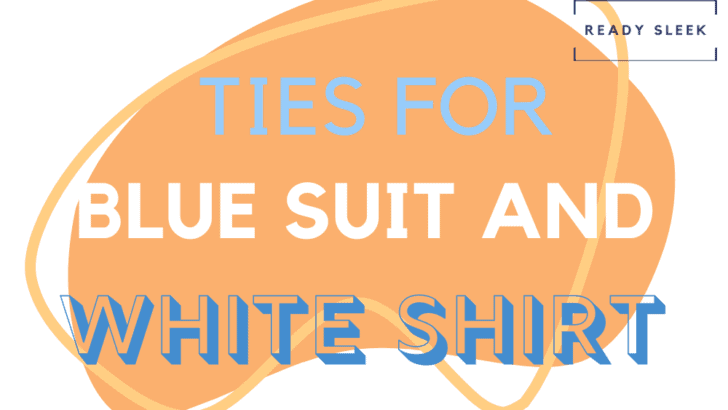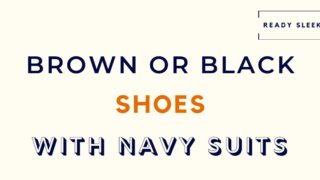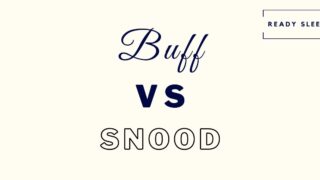Wearing a blue suit with a white shirt is extremely common, but adding a tie into the mix can sometimes cause some frustration. The wide range of tie colors you could choose from can get overwhelming, especially because certain colors will always look better than others.
So, here’s a list of some great tie colors you can wear with a blue suit and a white shirt:
- Black
- Red
- Gold
- Green
- Purple
- Pink
- Yellow
While that’s the gist, you’ll need more.
After going through those tie colors in more detail to help you choose the perfect one, we’ll run through a couple of FAQs on the topic to really finish up in style.
Let’s get to it.
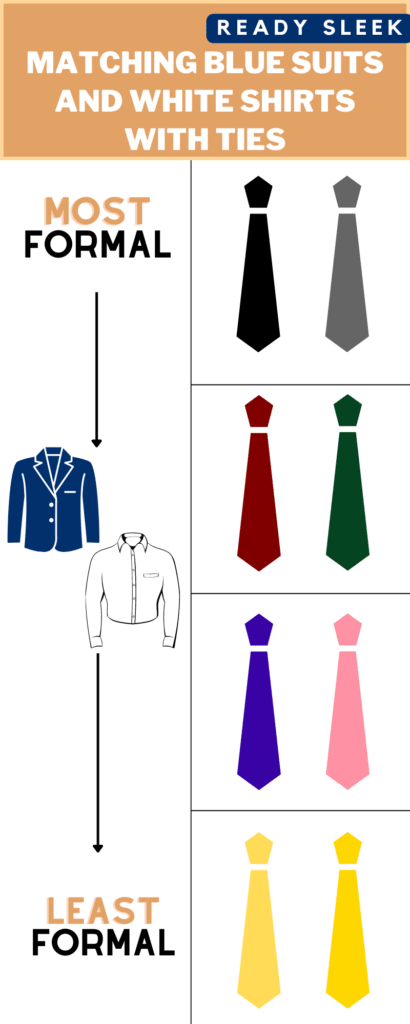
7 Tie Colors You Can Wear With A Blue Suit And White Shirt
You’ll notice how certain tie colors tend to look dressier and more formal than others. The dress code is one of the first factors to consider.
We’ll highlight the dress codes these tie colors are most suited to as we go through the list.

Black Tie
A black tie can be worn with a blue suit and a white shirt in a variety of different settings. Given how neutral it is, it will coordinate effortlessly and is also one of the dressiest tie colors you could go for.
Appropriate Dress Codes: Formal, Business-Professional, Smart-Casual

When wearing this combination to a “formal” dress code, go for a white shirt and a suit in a dark shade of blue such as navy or midnight blue.
In “business-professional” settings (eg. corporate workplaces), suits in these darker shades of blue would usually be best too.
In “smart-casual” settings, suits in light/medium shades of blue (eg. admiral, steel, or teal blue) can also be worn.
Ultimately, however, a black tie and a white shirt would pair seamlessly with any of these shades of blue. Given how formal the suit and tie combination is, it gives you the benefit of versatility.
Red Tie
A red tie can easily be worn with a blue suit and a white shirt, with ties in darker shades of red such as maroon or burgundy being better options in dressier settings.
Appropriate Dress Codes: Formal, Business-Professional, Smart-Casual

Once again, the shades of the blue suit and the red tie make a huge difference to how the outfit looks overall.
The more formal the setting, the more likely it is that dark shades of blue and red would be more appropriate.
A light, bright, and bold red tie (eg. scarlet red) can be worn with a blue suit and a white shirt effectively, but will generally look more casual than darker shades of red would.
It would be more suitable for a smart-casual setting than it would be for a more formal one.
Gold Tie
A gold tie can be worn with a blue suit and a white shirt very effectively, often working best for smart-casual events. The “warm” undertones of the gold tie will add a nice sense of balance to the “cool” undertones of the blue suit.
Appropriate Dress Codes: Smart-Casual

While a darker and more neutral tie color would usually be more appropriate in truly formal settings, a gold tie could be a reasonable alternative if you were looking for more of a statement piece.
In general, however, a gold tie would usually be inappropriate in business-professional settings, no matter how “professional” the blue suit and white shirt may be.
It tends to have more of a celebratory look to it and wouldn’t generally be acceptable in business-professional environments.
Overall, the gold tie, blue suit, and white shirt outfit works best in smart-casual settings where there’s less of a risk of underdressing.
If you feel as though the setting is more formal and there is a real risk of underdressing, consider a darker and more muted tie color instead. For example, black, charcoal, navy, or burgundy.
Green Tie
Green ties can be very effectively combined with a blue suit and white shirt combination. Ties in dark and muted shades such as forest, hunter, or sage green would be more appropriate in formal and business-professional settings.
Appropriate Dress Codes: Formal, Business-Professional, Smart-Casual

Once again, the more formal the setting, the more likely it is that dark blue suits and dark green ties would be the best option here.
In general, the same would go for business-professional workplaces, although you may get away with ties in lighter shades here.
In smart-casual settings you’ve got the freedom to go with suits and ties in lighter shades if you wanted to.
The lighter the shades, the more casual the combination will look.
Ultimately, the beauty of wearing a white shirt is that it’s neutral enough to anchor the suit and tie combination no matter what.
Combining two “cool” colors (i.e blue and green) often looks great. It produces a laid-back and relaxed aesthetic, compared with the more vibrant and striking effect a “warm” tie color would produce.
Purple Tie
Purple ties can be combined with a blues suit and a white shirt in settings ranging from formal to smart-casual.
Appropriate Dress Codes: Formal, Business-Professional, Smart-Casual

Purple signifies royalty, rarity, and mystery (if you believe in that stuff).
At the end of the day, it’s just a vivid and eye-catching color that works exceptionally well with blue.
Much like green, it’s a “cool” color and a purple tie will coordinate very effectively with the analogous blue suit.
Once again, darker shades of blue (eg. navy and midnight) and darker shades of purple (eg. plum and mauve) would be better in more formal settings.
In more casual settings, consider ties in lighter shades of purple such as lilac.
A quick word on pocket squares.
Try to coordinate it with the tie.
In formal settings, neutral pocket squares (eg. white or grey) would be best.
In more casual settings, consider adding another splash of color after taking the tie into account.
Using the example of a purple tie, you could go for a monochromatic combination by choosing a tie in a different shade of purple.
Alternatively, you could go for an analogous combination by choosing a pocket square in a color that’s close to purple on the color wheel. A shade of blue or green would work well here.
Pink Tie
A pink tie can be worn with a blue suit and a white shirt in formal and smart-casual settings. The “warm” pink tie produces a nice sense of harmony with the “cool” blue suit.
Appropriate Dress Codes: Smart-Casual

Pink ties are eye-catching and striking, even more so than red ones.
If you were looking for a more subtle and understated aesthetic, it probably wouldn’t be the best option.
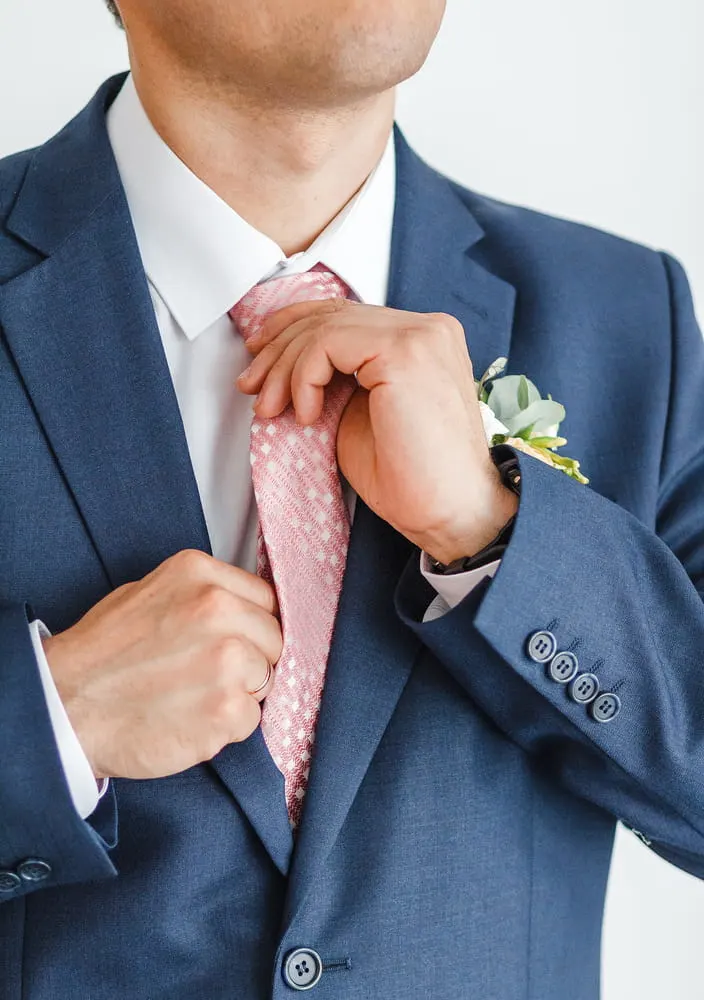
It’s one of the reasons why it usually wouldn’t work well in business-professional settings where a more “professional” tie color would be more appropriate.
It can look OK in formal settings, although darker and more neutral colors would usually be better options.
A blue suit, white shirt, and pink tie combination can work exceptionally well in more casual, social, and celebratory settings such as weddings or garden parties.
For a more subtle and elegant look, go for a dark blue suit and pair it with a tie in a dark shade of pink such as salmon.
Yellow Tie
A yellow tie can work well with a blue suit and white shirt combination, especially in smart-casual settings where there’s little risk of underdressing. Overall, the outfit will have quite a striking aesthetic to it.
Appropriate Dress Codes: Smart-Casual

Much like gold and pink ties, yellow ties are vivid and eye-catching against the backdrop of a blue suit and a white shirt.
Of course, bolder shades of yellow will look more eye-catching and in-your-face than darker and more muted shades.
But overall, the “warmth” and energy of a yellow tie makes it quite attention-grabbing.
In smart-casual settings, the combination can look great.
In formal and business-professional settings, however, it’s usually best to go for a more subtle and understated option for your tie color.
Go for a dark neutral (eg. navy, charcoal, black) or a dark and muted shade of red, green, or purple.
Frequently Asked Questions
Here are the answers to a couple of FAQs on the topic.
Can You Wear A Blue Suit And A White Shirt With No Tie?
A blue suit can be worn with a white shirt and no tie in smart-casual settings where a necktie wouldn’t be considered necessary.
It comes down to the setting and the dress code.
In truly formal or business-professional settings, a necktie would usually be considered essential.
In smart-casual settings, embracing the casual aesthetic by ditching the tie and leaving one or two buttons undone would often look great.
What Tie Should You Wear With A Blue Suit And White Shirt To An Interview?
When wearing a blue suit and a white shirt to an interview, consider a tie in a dark and neutral color such as black, charcoal, or navy. In addition, go for a suit in a dark shade of blue (eg. navy or midnight blue) whenever possible.
Overall, it’s best to play it safe when going for an interview.
Avoid ties that are too bold or attention-grabbing. It’s best to come across as though you’re not trying too hard to impress, while also looking sharp and smart enough for the role you’re applying for.
Ready Sleek founder. Obsessed with casual style and the minimalist approach to building a highly functional wardrobe. Also a fan of classic, vintage hairstyles.

